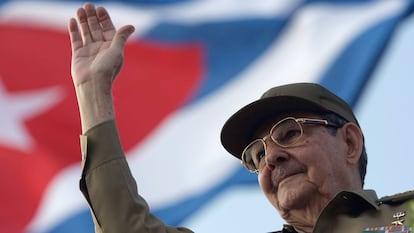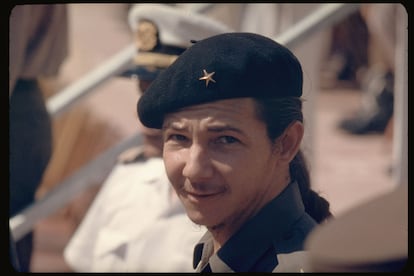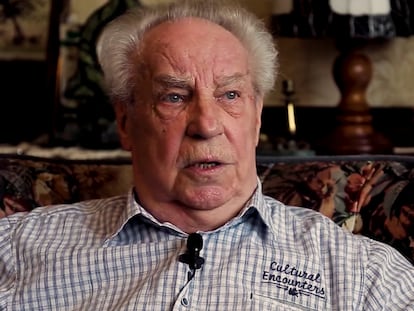Raúl Castro’s last mission: Ensuring Cuban socialism outlives its founders
The former president and last Cold War survivor will turn 91 in June and he remains an active presence even though he no longer holds political office

On April 19 of last year, Raúl Castro voluntarily bowed out of his last and surely most important role, that of Secretary General of the Communist Party of Cuba (PCC). Nineteen months earlier, he had handed over the presidency of the country to Miguel Díaz-Canel.
Having supported his elder brother Fidel, the so-called líder máximo, throughout his life, filling his shoes when the latter fell ill in 2006, Raúl meticulously organized his own succession, establishing a limit of two five-year terms for high office, and promoting Díaz-Canel as president in a Cuba without a Castro at the helm for the first time in 60 years.
But, in the 12 months since he abandoned the political front line, Raúl Castro has remained a pivotal figure in Cuba and cannot entirely be considered a retired ex-president despite the fact that he will be 91 in June.
The day after the massive protests on July 11, 2021, he attended the emergency meeting held by the Political Bureau of the PCC to analyze what was going on and, five days later, dressed in his uniform as Army General, he participated in “an act of reaffirmation” with Díaz-Canel and the island’s main political players.
In his last public appearance at the May 1st parade little more than a week ago, Raúl showed that he was very concerned that the fundamentals of socialism should endure and was especially aware of the “work being undertaken by the new generations leading the Party,” starting with President Miguel Díaz-Canel, his personal choice to guarantee the continuity of the Cuban political system. “He is working very well and very hard; sometimes more than is necessary,” he declared.
After half a century managing the revolution’s engine room and ensuring its logistics, and an additional 10 years as head of the country and the PCC following Fidel’s decline, Raúl Castro is quite possibly undertaking his last great mission and his greatest challenge to date: the survival of socialism in Cuba beyond that of its founders.

Raúl is apparently still in good health; the Army General Office is still active and Castro remains informed of the most relevant PCC and government meetings, invariably offering his opinion. And these opinions obviously carry weight and act to reassure those veterans who have worked alongside him, who point out that “no one would think of not consulting him on key issues.”
Certainly, what has happened in Cuba since 1959 cannot be understood without the figure of Raúl, perhaps the last great survivor of the Cold War and of the international politics of the second half of the 20th century. If Fidel was the founder, the charisma and the driving force behind the revolution, Raúl was its main guarantor and supporter, as both head of the army and an active participant in the day-to-day political life of the communist party. According to former CIA analyst Brian Latell, author of the well-known biography After Fidel: the Inside Story of Castro’s regime and Cuba’s Next Leader, Raúl Castro was the only “truly indispensable leader of the regime,” without whom Fidel would not have been able to remain in power for decades; it was Raúl who kept things oiled beyond the realms of his brother’s wishes and dreams.
Another intelligence analyst, Nikolai Leonov, from the dissolved Soviet intelligence service, the KGB, recalls that Raúl took care of strategic relations with the former Soviet Union for 30 years, and was in the line of fire during the island’s most delicate episodes, such as when a drug trafficking trial against General Arnaldo Ochoa and other senior military commanders shook the pillars of the state in 1989.
During the crisis of the Special Period, while the country was struggling economically and starvation was on the doorstep, Raúl personally convinced the party of the need to reopen the agricultural markets to the law of supply and demand as armed forces minister (1959-2008), a concession to capitalism and a reform that hardliners viewed with suspicion. “Beans are more important than cannons,” Raúl famously pronounced, thus closing the debate.

Like Fidel, Raúl was educated by the Jesuits, and, like his brother, he fought for his political ideals at the University of Havana. In fact, Raúl was present at all the revolution’s milestones: in the assault on the Moncada Barracks (1953), in the landing of the Granma yacht (1956), in the struggle of the Sierra Maestra (1956-1958), and also – as military chief of the country’s eastern region – in the Bay of Pigs invasion (1961) and the Missile Crisis (1962). When the dismantling of the Soviet Union plunged the country into recession in the 1990s, Raúl decided the way to get it back on its feet was to develop the private sector. He had previously experimented with the so-called “entrepreneurial self-management system” in the military enterprises under his command with some success, a formula that gave more incentives to workers and more autonomy to managers in search of greater economic efficiency.
“If, in all circumstances, Fidel has been the commander in chief, Raúl has always remained the chief of his general staff,” Leonov concluded in his profile of the younger Castro, a personal friend since 1953, one of whose main qualities Leonov flagged up as his “pragmatic approach to governance.”
When it was his turn to take the reins in 2008 after his brother’s resignation, Raúl pressed on with policies designed to trigger economic change and launched an initiative to put an end to what he called “absurd bans” and “undue gratuities.” Thanks to the latter move, Cubans were finally able to stay in the same hotels as foreign tourists, buy computers, own cellphones and sell their houses and cars. Gradually, more people began to the use the internet and the humiliating “white card,” or exit permit, which was mandatory for any Cuban wanting to travel, was ditched. The new president also began to dismantle the entire apparatus of subsidies, inflated workforces and economic support for unprofitable companies that underpinned Fidel’s dream of an egalitarian society for decades.
Unlike Fidel, who authorized self-employment during the 1990s crisis but considered it a “necessary evil” which he stifled when he could, Raúl promoted it. In 2008, there were about 150,000 self-employed workers in Cuba; today there are more than 600,000 – 13% of the working population – while there are about 3,000 small and medium-sized private enterprises on the island.
But, according to prestigious Cuban economists, the changes Raúl got behind, though important, were insufficient and too slow, adhering to the Raulist motto of working “without haste but without pause.”
Aware that his brother’s charisma and his manner of exercising power were inimitable, Raúl designated the communist party as “Fidel’s only worthy heir,” on his arrival at the Palace of the Revolution, and promoted collective decision-making, putting an end to personal politics and relying on the strengths of the country’s institutions instead. Raúl also dedicated considerable time at the beginning of his period at the helm to “forging consensus” and to reinstating the lost protagonism of the Councils of State and Ministers, in contrast to Fidel’s modus operandi which often involved important decisions being taken in his office in the presence of just a small group of collaborators.

In his 10 years as president between 2008 and 2018, nothing substantial changed politically: Cuba remained a single-party country, controlled by the state and subject to a central planning system, with no room for dissidence. The economic reforms drove change, but with ups and downs, and on more than one occasion Raúl himself railed against the “old mentality” entrenched in the darkest corners of the civil service, demanding a stop to obstacles frustrating the wheels of change and “the unblocking of productive forces.”
Either he could not, or he did not want to succeed. But the truth is that Raúl paved the way for economic change, although he also defined its limits before stepping down as secretary general of the PCC after delivering his last speech at its VIII Congress in April 2021. The number of private work initiatives that Cubans could engage in had just been significantly increased and the law on SMEs was about to be approved, but there were also demands from various platforms for private practice in professions such as architecture and law, and an end to the state monopoly on foreign trade.
Raúl was categorical; he said this path would soon initiate “a privatization process that would sweep away the foundations and the essence of the socialist society that had been built over more than six decades.” And he left his successors with the following message: “These are issues that should not be subject to confusion and much less to naiveté on the part of the leadership cadres and party members. There are limits that we cannot exceed because the consequences would be irreversible and would lead to strategic errors and the very destruction of socialism and, therefore, of national sovereignty and independence.” It was a message that poured cold water on the hopes of those sectors keen to see deep-seated reforms.
A key moment of Raúl’s presidency was the normalization of relations between Cuba and the US which he negotiated with Barack Obama, a move unthinkable under Fidel. In 2016, in a symbolic visit, Raúl received the former US president on the island. But then Donald Trump arrived at the White House and any gains were dismantled. Undoubtedly, settling the long-standing dispute between the two countries would have been an important legacy for Raúl’s successors. But it was not to be.
Before leaving the presidency, Raúl established a limit of two five-year terms for high office, which in the case of Díaz-Canel will be 2029 as president and 2031 as secretary general of the PCC. By then, we might have some idea whether Raúl’s mission – and last assignment – to keep Cuban socialism alive can succeed.
Tu suscripción se está usando en otro dispositivo
¿Quieres añadir otro usuario a tu suscripción?
Si continúas leyendo en este dispositivo, no se podrá leer en el otro.
FlechaTu suscripción se está usando en otro dispositivo y solo puedes acceder a EL PAÍS desde un dispositivo a la vez.
Si quieres compartir tu cuenta, cambia tu suscripción a la modalidad Premium, así podrás añadir otro usuario. Cada uno accederá con su propia cuenta de email, lo que os permitirá personalizar vuestra experiencia en EL PAÍS.
¿Tienes una suscripción de empresa? Accede aquí para contratar más cuentas.
En el caso de no saber quién está usando tu cuenta, te recomendamos cambiar tu contraseña aquí.
Si decides continuar compartiendo tu cuenta, este mensaje se mostrará en tu dispositivo y en el de la otra persona que está usando tu cuenta de forma indefinida, afectando a tu experiencia de lectura. Puedes consultar aquí los términos y condiciones de la suscripción digital.
More information
Últimas noticias
Most viewed
- Oona Chaplin: ‘I told James Cameron that I was living in a treehouse and starting a permaculture project with a friend’
- Reinhard Genzel, Nobel laureate in physics: ‘One-minute videos will never give you the truth’
- Sinaloa Cartel war is taking its toll on Los Chapitos
- Why the price of coffee has skyrocketed: from Brazilian plantations to specialty coffee houses
- Silver prices are going crazy: This is what’s fueling the rally










































